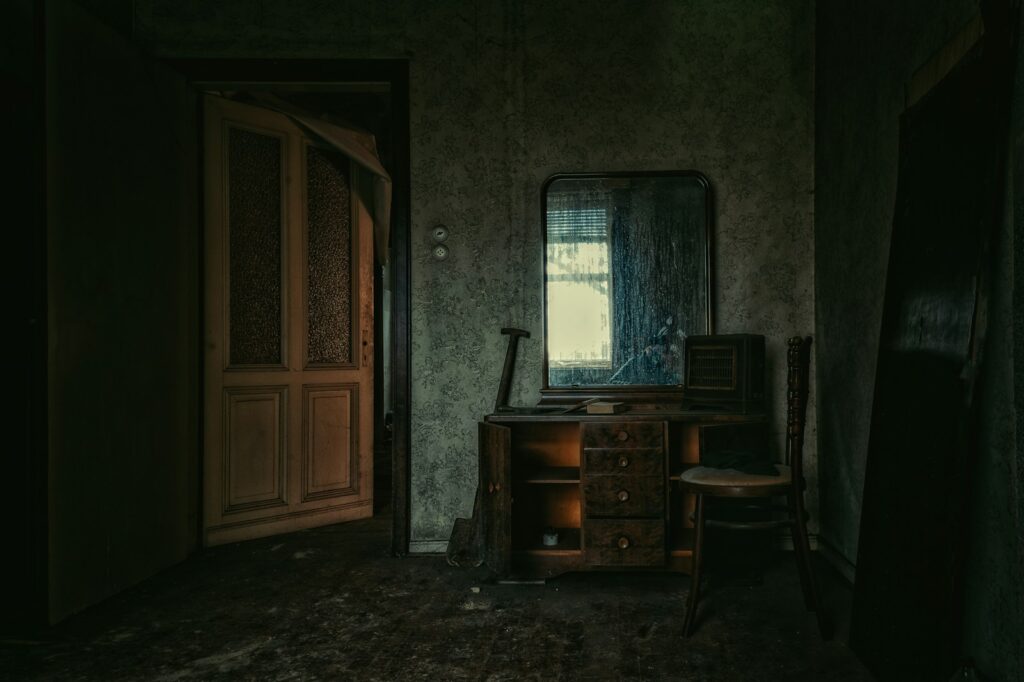We all hold an idealized image of childhood—a time filled with sunshine, playgrounds, cartoons, and bedtime stories that always end happily. Childhood is often regarded as a pristine bubble of innocence before the harsh realities of life make their presence felt.
However, what if this nostalgic image is less flawless than we remember? Some of those seemingly innocent stories contain unsettling plots beneath their surface. Moreover, certain individuals have faced real-life experiences so grim that they render these eerie tales almost benign by comparison. Prepare yourself for an exploration into these unsettling truths.
Through extensive research, including an in-depth review of a particularly compelling document, we have uncovered facts and story summaries that may cause you to hold your childhood memories with newfound caution. This journey will reveal dark realities and disturbing narratives capable of reshaping your sentimental view of childhood.

Charlize Theron’s Unimaginable Real-Life Horror
Charlize Theron’s early life starkly contrasts with the glamorous persona she presents today. Raised on her parents’ farm in Benoni, near Johannesburg, South Africa, she endured a profoundly traumatic experience at the age of 15.
Theron revealed that her mother, Gerda Maritz, fatally shot her father, Charles, after he returned home intoxicated and threatened both women with a firearm. Authorities determined the incident to be an act of self-defense, and no charges were filed against her mother. Bearing such a heavy burden from a young age is unimaginable.
For years, Theron coped by suppressing the truth, choosing to tell others that her father had died in a car accident. She found it difficult to confront the reality and resisted embracing a victim identity. It was not until her late twenties or early thirties, through therapy, that she began to process the lasting impact of her childhood. She emphasized that the trauma extended beyond that singular event to encompass the daily reality of living with an alcoholic parent—the unpredictable nature of each day and the emotional toll it exacted.
Theron credits her mother, who never sought therapy herself, for instilling resilience and courage through a powerful philosophy: “This is horrible. Acknowledge that this is horrible. Now make a choice. Will this define you? Are you going to sink or are you going to swim?” This formidable message of strength shaped Theron’s perspective on life.
She acknowledges that their struggles were not confined to one night but were a continuous challenge. This early tragedy taught her a sobering lesson: “You don’t have forever.” Such a heavy and dark burden for any child to carry.

The Monkey’s Paw: A Tale of Wishes and Tragedy
W. W. Jacobs’ classic story, The Monkey’s Paw, is often known through simplified versions that soften its darker themes. The original narrative centers on Sergeant Major Morris, who possesses a monkey’s paw rumored to grant three wishes. While this premise appears intriguing, Morris delivers a grave warning: the wishes come with disastrous consequences.
Ignoring this caution, the White family—comprising Mr. White, his wife, and their son—acquires the paw. Their initial wish is for financial gain. The following day, a representative from the son’s workplace arrives with tragic news: the son has perished in an accident. The family receives compensation equal to the amount they wished for, fulfilling the wish at a devastating cost.
Overcome by grief, Mrs. White uses the second wish to bring their son back to life. Soon afterward, a persistent knocking begins at the door, growing more urgent and unsettling. Someone—or something—is attempting to enter, possibly to retrieve the paw. Aware of the unfolding horror, Mr. White makes a final, desperate wish. When his wife opens the door, no one is there. The chilling ambiguity of what stood outside and what the last wish entailed leaves a haunting impression. This story is far from a comforting fairy tale.

The Furnished Room: A Haunting Tale of Loss and Despair
O. Henry is renowned for his unexpected twists, and this story delivers one of the most unsettling. It follows a young man relentlessly searching for his beloved, Eloise Vashner, in the vibrant city of New York. For months, he has inquired everywhere—among theater managers, audiences, and anyone who might have information—yet his efforts remain fruitless.
Eventually, he rents a furnished room. The housekeeper mentions that the room is frequently occupied by theater professionals, prompting him to ask if a young woman named Eloise Vashner had ever lived there. She denies any knowledge of such a tenant. As the young man settles into the room, he detects a faint, sweet scent. Instantly, he recognizes it as Eloise’s perfume.
Overcome with grief and desperation, he speaks to the scent, convinced she must have been in that very room. His frantic search yields no evidence. He questions the housekeeper again, who reiterates her denial. Crushed and hopeless, he chooses to end his life by turning on the gas in the room. Shortly thereafter, the housekeeper confides to a friend that she had withheld a grim secret: a tenant had committed suicide in that same room only a week earlier, also by gas. The scent was not merely a memory; it was a harbinger of something far darker.

The Tell-tale Heart’s Unbearable Thump
Edgar Allan Poe’s mastery of psychological horror is exemplified in The Tell-Tale Heart, a story that chronicles a gradual descent into madness. The narrator begins by asserting his sanity, claiming to be merely “hypersensitive,” while recounting the murder of an old man who had caused him no harm. His motivation lies in the old man’s pale blue eyes, which he finds intolerable.
The narrator details his careful planning and execution, insisting that such calculated behavior proves his sanity. Night after night, he sneaks into the old man’s room, watching him with a lantern. On the night of the murder, the lantern slips and awakens the old man. The narrator kills him and then meticulously conceals the crime by dismembering the body and hiding the remains beneath the floorboards, all with chilling composure.
When three policemen arrive following a neighbor’s report of a scream, the narrator remains outwardly calm and confident. He claims the old man is away and invites the officers into the room, seating them directly above the hidden remains. However, as the conversation progresses, the narrator becomes increasingly agitated. He begins to hear a persistent thumping, growing louder with each moment. Convinced it is the old man’s heartbeat emanating from beneath the floor, he succumbs to guilt and hallucination, ultimately confessing to the murder and attributing the sound to the old man’s restless spirit. This narrative offers a harrowing insight into a fractured mind.

The Lottery’s Deadly Tradition
Shirley Jackson’s The Lottery remains one of literature’s most striking examples of horror concealed beneath the appearance of normalcy. The story begins on a summer morning in a quiet village, where residents gather for what appears to be a cheerful annual event: the lottery. The mood seems calm, though a few villagers display subtle signs of unease.
As Mr. Summers and Mr. Graves bring out a worn black box, the ritual begins. Each family’s head draws a slip of paper while the townspeople exchange casual conversation. However, the atmosphere gradually shifts, and an underlying tension becomes unmistakable. When Bill Hutchinson draws the slip marked with a black dot, the true nature of the event begins to emerge.
His wife, Mrs. Hutchinson, immediately voices her protest, making it clear that this is not a prize to be celebrated. Her objections are met with disturbing indifference, as the villagers insist she “be a good sport.” The Hutchinsons, a family of five, must participate in a second round of drawing. Mr. Summers prepares five slips—one for each family member. Mrs. Hutchinson draws the marked slip once again. Mr. Summers then calmly instructs the crowd to “finish it fast.”
At this moment, the story’s grim tradition is fully revealed. The lottery ends not with a reward, but with communal execution. The villagers, including children, begin throwing stones at Mrs. Hutchinson, who becomes the sacrificial victim in a ritual disguised as civic routine. This harrowing conclusion exposes the terrifying power of blind adherence to tradition.
Having now examined the darker sides of stories once thought harmless, it becomes clear that innocence often masks something far more disturbing. The first seven entries have already challenged comforting notions of childhood and folklore. What follows delves even deeper into unsettling narratives that reshape how we remember tales from our formative years. The next selections reveal just how easily the line between innocence and horror can blur.

The Fall of the House of Usher
Edgar Allan Poe’s The Fall of the House of Usher remains a powerful meditation on madness, decay, and the supernatural. The story begins as the unnamed narrator travels to the Usher estate to visit his ailing friend, Roderick Usher, who has written claiming to suffer from a mental disorder. Upon arrival, the narrator is immediately struck by the mansion’s oppressive atmosphere. The house appears ancient, decaying, and filled with an overwhelming sense of dread.
Roderick and his twin sister Madeline are the last surviving members of the Usher bloodline, a family long associated with artistic sensitivity and eccentricity. Roderick, visibly deteriorating, exhibits extreme sensitivity to light, sound, and even texture. He believes his death is imminent. Madeline, who suffers from catalepsy—a condition that mimics death—is also in a fragile state. Roderick insists that the house itself is sentient, capable of perceiving the emotional decay of its inhabitants.
Despite the narrator’s attempts to lift Roderick’s spirits, the oppressive mood persists. One day, Roderick declares that Madeline has died. Together, the two men entomb her body in a sealed vault beneath the mansion. Several days later, a violent storm erupts. Unable to sleep, the narrator reads aloud to Roderick to calm his nerves. Strangely, the sounds from the story begin to echo through the house. Roderick grows frantic, eventually crying out that they buried Madeline alive.
In a moment of terror, the vault door bursts open. Madeline, bloodied and disoriented, appears and collapses onto Roderick. He dies instantly from shock. The narrator escapes the house as it begins to collapse, witnessing the mansion crack apart and sink into the ground. The physical destruction of the house mirrors the complete annihilation of the Usher lineage, as madness, fear, and the supernatural converge in one final, devastating act.

The Masque of the Red Death
In Edgar Allan Poe’s haunting tale The Masque of the Red Death, a terrifying plague known as the Red Death devastates a kingdom, claiming half its population. In response, Prince Prospero retreats into isolation, sealing himself and a thousand aristocratic guests inside his fortified castle. The gates are welded shut, cutting them off from the horrors outside. Within, they immerse themselves in music, wine, and endless celebration, determined to outlast the disease through indulgence and denial.
After six months of seclusion, Prospero hosts an extravagant masquerade ball. He decorates seven interconnected rooms, each in a distinct color. The final room, entirely black with blood-red windows, exudes an ominous atmosphere. A massive ebony clock stands within, its hourly chime so disconcerting that each ring causes the revelers to fall silent. Despite the festivities, the looming presence of mortality cannot be ignored.
At the stroke of midnight, the crowd becomes aware of a strange new figure, cloaked in funeral garb and resembling a corpse. Enraged by what he sees as a grotesque mockery, Prospero pursues the figure through the suite of rooms, drawing ever closer to the black chamber. As the figure turns to face him, Prospero collapses and dies.
Only then do the guests realize the horrifying truth—it is not a costumed guest at all, but the embodiment of the Red Death itself. No fortress could keep it out. The party ends not with applause, but with silence, as disease claims all within.

Childhood stories are often wrapped in warmth, nostalgia, and a sense of moral clarity. Yet, as these tales and real-life tragedies reveal, not all memories from youth are as innocent as they seem. Behind the veneer of fables and folklore lie shadows—warning us, shaping us, and sometimes haunting us. By revisiting these darker narratives, we gain a deeper appreciation of storytelling’s power—not just to comfort, but to challenge and unsettle. The line between fairy tale and nightmare is thinner than we once believed.



:max_bytes(150000):strip_icc()/Lindsay-Lohan-Lead-c7954a0abb77468fa58e71c63cabd61c.jpg)
